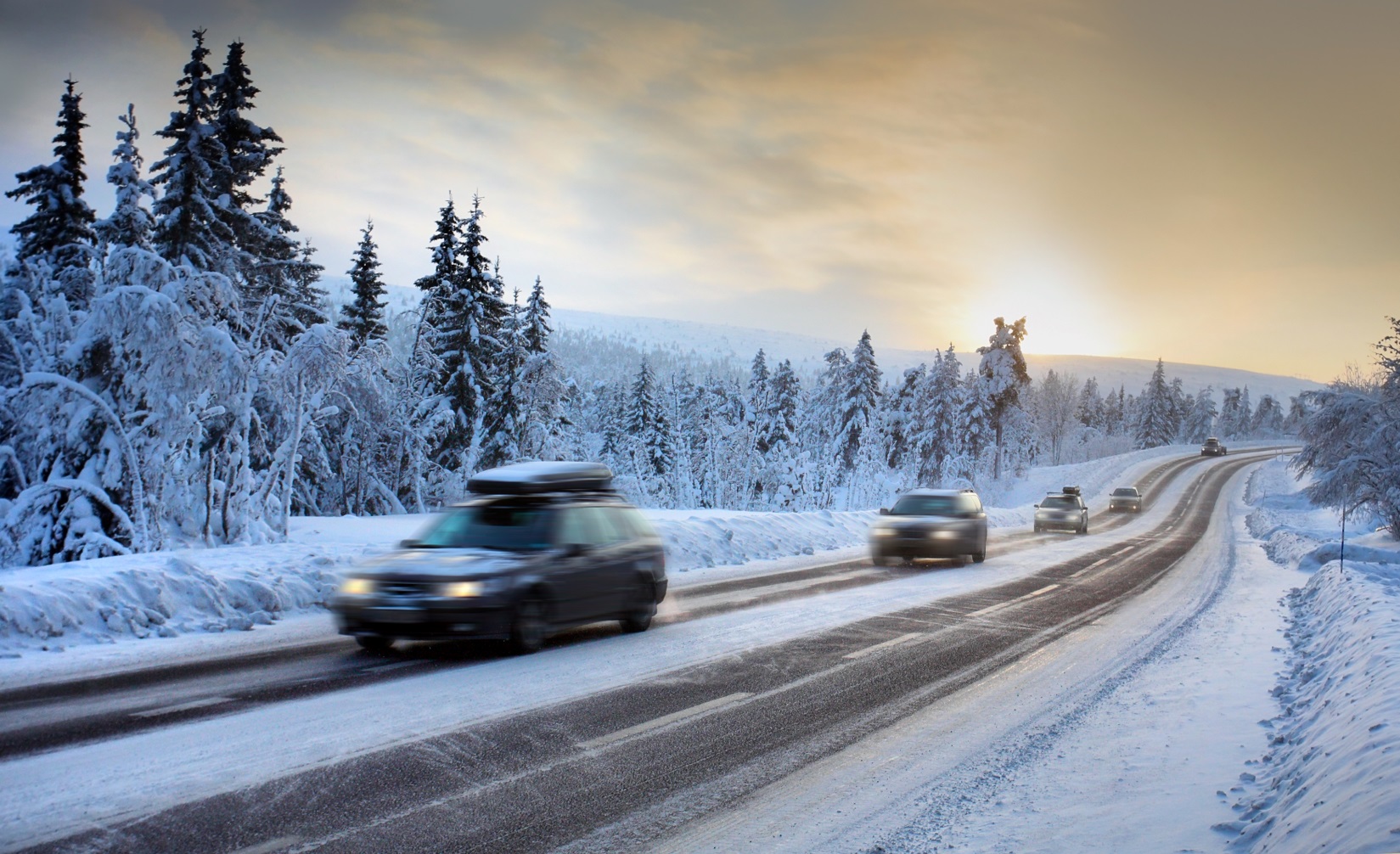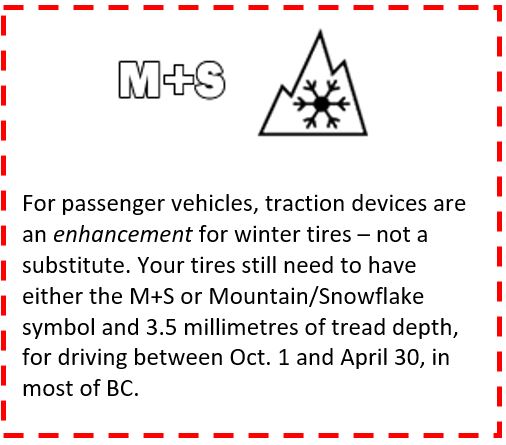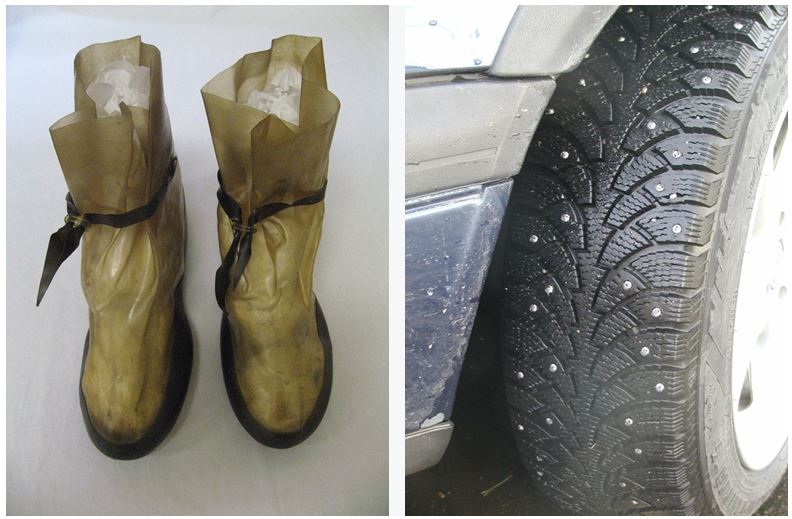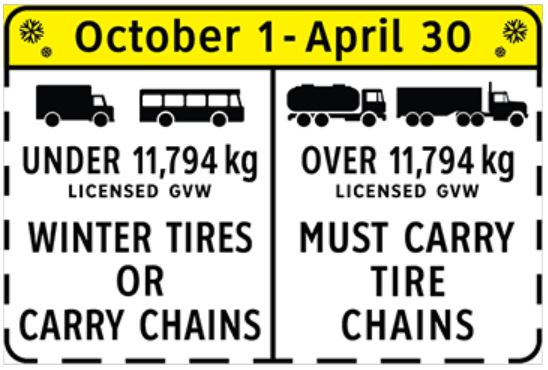
Have you ever seen overshoes, ice cleats or the old-style rubber covers people used to wear over their dress shoes to prevent slips and falls on ice?
Did you know you can apply that same idea to your vehicle’s tires? Here’s a rundown of some traction devices that can help keep you and your vehicle travel safely and smoothly along in winter.
TRACTION DEVICES FOR PASSENGER VEHICLES AND COMMERCIAL VEHICLES (5,000 – 11,794 kg LGVW)
Chains
We recommend that drivers travel on tires with the mountain/snowflake symbol for cold weather driving and, for extreme conditions, to carry chains and know how to use them. If used, chains are installed on the tires of a vehicle’s primary drive axle. Steel link chains provide the best traction in snow and ice and prevent lateral slippage.
There are also cable style chains available. Be aware that cable chains do not deliver the same lateral traction as steel link chains, and vehicles can actually slide on sloped curves.
For those who operate commercial vehicles under 11,794 kg, please check the configuration requirements for chains or other traction devices.
Automatic Tire Chains
Automatic tire chains can be installed and removed from the safety and comfort of the driver’s seat, eliminating the need for manual installation of chains. Talk about convenient!
Studded Tires
Similar to ice cleats for shoes or boots, studded tires have raised metal nubs that dig into icy or snowy roads. The studs should not stick out more than two millimetres from the tread or the traction surface of the tire. Because they’re tough on bare pavement, they can only be used from Oct. 1 to April 30. (If you use them beyond that date, you could get a fine!)
If you’re driving with studded tires, it’s ideal to have them on all four wheels, for even traction. They can be installed on the rear wheels only, but never on the front wheels only. Check this excerpt from the British Columbia Motor Vehicle Act for more about this type of traction.
Textile Tire Covers (aka “Snow Socks”)
Think of how snow and ice stick to woolen mittens. It’s the same thing with textile tire covers (also known as snow socks). When the covers have been placed over your tires, the material (and your vehicle) wants to adhere to the road. When you’re on bare pavement though, the fabric wears down fast, so you’ll want to slip those socks off soon after you reach asphalt.
Wheel Sander
A wheel sander system puts down grit in front of your tires to increase traction. Handy!
CHAINS FOR COMMERCIAL VEHICLES — 11,794 kg LGVW +
For commercial vehicles that are licensed to carry loads of 11,794 kg or heavier, steel chains are the required traction device. These large vehicles must carry chains on most major highways, and drivers must know how to install them. It’s good practice to keep chains on board at all times, and mandatory for them to be carried Oct. 1 to April 30, if the vehicle is 11,794 kg LGVW+.
Commercial vehicles must use steel link chains as they have been proven to provide superior traction and prevent lateral slippage. Cable style chains are permitted only if used in conjunction with steel link chains which have been installed on the outside of a drive axle. Cable chains on their own do not provide enough traction on banked curves.
There are the required tire chain configurations for commercial vehicles.

Giving your tires a little help during the snowy, icy and slippery time of year, is an option to help you stay safe and on the road. It feels good to have your tires – like your feet – firmly on the ground.
I drive a Ram 1500 with m+s and tread depth of 4mm it also is a commercial vechile I.e ; used for work.
Do I still need chains to drive thru the coquihalla onto Kamloops ?
Hi John. Commercial trucks weighing under 11,794 kg LGVW must carry chains or acceptable traction devices UNLESS the vehicle is equipped with winter-rated tires with the 3-peaked mountain and snowflake symbol or the M+S symbol. While M+S tires with a tread depth of at least 3.5 mm of tread depth meet the minimum legal requirement, we recommend the 3-peaked mountain and snowflake tires, which provide better winter performance, for vehicles travelling winter tire routes such as the Coquihalla. Hope this helps. Safe travels.
I work at a transport company and we had a tractor trailer go through a scale, officer apparently told our driver that tire socks will not be recognized as legal traction device in BC as early as next year, is this true?
Hi Bruce – thanks for your question.
In April, the Ministry announced that we will be enhancing chain regulations and increasing fines associated with non-compliance. At this point, we are still working through the specific details of those regulation enhancements, and what traction devices will be considered adequate. We expect to implement the new regulations this winter, but recognize that it may take some time for industry to learn and adapt to the new regulations. Please stay tuned for more information as changes are rolled out. Thanks!
Will Appreciated
You might want to check the legend on the tire chain configurations PDF. There are two symbols labeled ‘driving axle (with chains)’ and I think the lower one should read ‘driving axle (WITHOUT chains)’
Good catch Nick – thanks! We are working on updating right now.